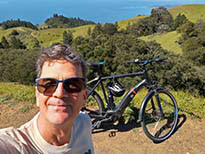* * *
If you go to Muir Woods really early -- I mean really early -- you can always beat the crowds, even on a weekend. But government shutdowns? Those you can't beat.
Purely out of historical interest I headed down to Muir Woods to photograph the closure sign, which reads, "Because of the federal government shutdown, this National Park Service facility is closed." Nothing snarky, though the temptation must have been fierce. Just the sad fact, black ink on white paper. Later on I would see a tour bus at Rock Spring for the first time ever. French-speaking people milled around outside the bus: "Ou sont les frickin' redwoods?" Some of them visited the portable toilets. Somewhere in the distance, a cabal of Republicans were high-fiving each other for screwing a busload of French people out of a trip to Muir Woods.
I'd been thinking about getting over to the coastal feet of Mt. Tam since I hadn't been out that way in a long time. The wind was still blowing pretty hard from the east, and I had to use the Jeep as a windbreak to make this 30-second exposure along the Shoreline Highway north of the Muir Beach Overlook.
I didn't have anyplace in mind to shoot from, so I stopped at a few different pull-outs and decided this one would do.
This is another view from the same pull-out. That spit of land in the distance is Bolinas. When the sun finally rose, it touched the very tip of that spit and worked its way inland.
I have never stayed at the Steep Ravine Environmental Campground. It looked pretty quiet down there, but I see that they are closed this month for maintenance. I've heard it's not easy to get reservations on the spur of the moment, but one of these days I'm going to have to make a plan and spend a couple of days there.
When the original Forty-Niners saw this stretch of coast, there wasn't a pampas grass in sight. It was introduced in Santa Barbara in 1848 and has since spread throughout the state.
Dawn at Stinson Beach.
I swung a right just before Stinson Beach and drove up toward Pantoll, reacquainting myself with this stretch of road. Along the way I spotted this fern-filled canyon and had to stop to check it out. I guess I made some noise clambering up the hill; I could hear a deer loudly chuffing in indignation from farther up the canyon.
Heading up to Rock Spring I was passed by several Ferraris whenever I stopped at a pull-out. They appeared to be gathering for a group photo. I had moved on by the time they left, but you couldn't miss hearing them go, as they all revved their engines for maybe half a minute before they went.
On my way to check out the trail camera I stopped to photograph some ripe peppernuts (bay laurel).
The coast live oak acorns were still green.
I haven't had much luck with the trail camera since that first week. I had one week with no animals at all -- but lots of pictures of wind-blown trees -- and a second week with just a single deer. It's amazing to realize that a game trail can go completely unused for a whole week. I moved the camera to a pretty good trail for the coming week, but I'm thinking about moving it back over to the west side of Bolinas Ridge next time. There's lots of coyote and bobcat scat along the trails, but it's all old. Maybe the animals don't use that area much this time of year.
I spotted some wild turkeys and American goldfinches on my way back from setting up the camera.
They need a dexterous beak to separate the kernel from the fluff.
The meadowlarks are back!
* * *





















































